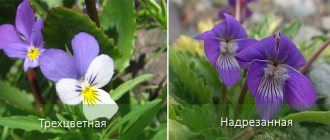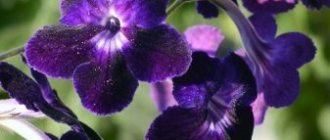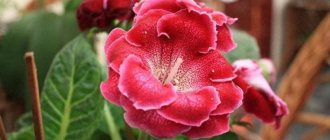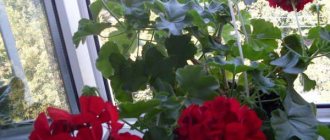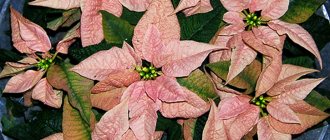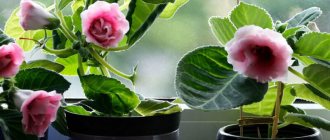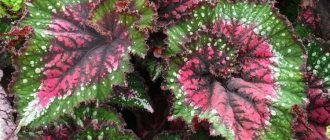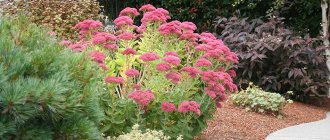- March 8, 2019
- Flowers
- Blackwhisker Rose
Boris Pasternak also wrote about how in winter, from behind the window frame, geranium flowers reach out to white snowflakes. This plant delights with bright colors and delicate aroma at any time of the year. Photos of geranium demonstrate the beauty of this flower, symbolizing comfort and warmth in the house. It is difficult to imagine the window sills and balconies of European houses without geraniums. In southern countries, it decorates parks and squares, delighting with bright colors all year round.
We invite you to get to know what geranium looks like, methods of propagation, and care tips. It has been proven to neutralize any negative energy in the room. This is a kind of amulet that extinguishes quarrels and protects the house from uninvited guests. We offer you the most interesting information about this wonderful flower.
Description of geranium
This plant is also called pelargonium. The word pelargos is translated from Greek as “stork”. The fruits of this flower look like a stork's beak. Geranium on the window will be useful to many. She is even considered a helper in love. It is important to note that this flower feels great not only in a pot, but also in the garden, in a flower bed. Today, about 300 species of pelargonium have been bred.
This plant was first discovered in the 17th century by botanist John Tradescan. As a result of long-term crossing of various types of wild geranium, a domestic variety was obtained. She arrived in Russia overseas as a gift. Once upon a time, the English king George III sent several plants to Catherine II to decorate the Pavlovsk Garden. For a long time, pelargonium was considered an aristocratic plant. Owners of rich mansions bred it in their greenhouses. Today it is used by all flower lovers. They remembered her because she is really gorgeous!
Homemade geranium, photos of which are posted in our article, can be tall and short. Its stems are covered with delicate fluff. The plant is characterized by beautiful rounded leaves with a wavy edge. Leaf color varies from bright green to dark bottle green. Sometimes there is a light border along the edges. Pelargonium leaves are also slightly pubescent. They contain essential oil, which can be released in the sun. This is a kind of protection against overheating.
Photos of geranium show that its flowers are collected in inflorescences that resemble bright hats. There are buds of very different colors: snow-white, soft pink, lilac, purple, burgundy.
Flower growers like homemade geraniums because these bushes, strewn with large umbrella inflorescences, are unpretentious, grow quickly, bloom profusely and multiply quickly. It is important to note that hanging varieties have also been bred, which look beautiful in hanging flower pots on balconies or verandas. A description of geranium without mentioning the ampelous type would be incomplete. We'll talk about it in more detail later.
Geranium. Description and care of geranium flower
Geranium was not known in Europe until the 17th century. The plant was brought from Africa. This is the birthplace of geranium . The flower did not grow on other continents. Now, the grass is found even in Siberian forests. The guest from Africa turned out to be able to perceive almost any climate and adapt to new conditions.
In the photo there is a royal geranium
In Russia, the cultivation of the geranium flower began only in the 19th century, although there are mentions of the plant in the notes of the 18th century. Let's find out how the grass has changed since then, what features it has acquired in a foreign land.
Features of geranium
Home geranium differs from forest geranium. It is a process of natural adaptation and artificial selection. The houseplant even began to be called differently - pelargonium. It can be bushy or creeping, that is, hanging. The foliage is always palmate, that is, it has several compartments.
They can be dissected or fused, resembling blades. Geranium leaf is useful in cooking as a seasoning. The greens of the plant are also placed in jars of jam so that it does not mold.
In the photo there is an indoor geranium
The geranium plant is medium-sized. The length of the stem is 40-60 centimeters. This is in cultivated varieties, the number of which has reached 300. Wild representatives of the Geraniaceae family can reach 120 centimeters. The herbs are perennial, living in one place for 15 to 15 years.
This indicator is almost not affected by climatic conditions. Geraniums can be planted in open ground without being covered for the winter. The plant will survive and will bloom in spring.
Geranium flowering depends on the variety. Most of them produce buds from May to October. Some plants have a year-round cycle. The buds are formed single, paired, or in umbrella inflorescences. The color of the petals is also affected. The most popular is red geranium . But the buds are also white, pink, and purple.
The aroma of flowers is released by geranium. The properties of the fluids make it possible to repel flies and snakes. Neither one nor the other can stand the smell of the plant. For humans, the aroma of geranium is pleasant. It’s also nice that the petals of pink pelargonium also repel moths. Housewives put dried flowers in wardrobes. The air in them is filled with sweetness, and the insects disappear.
Indoor geranium microbes . The number of bacteria in the air is reduced by half per day. This is data from scientists who studied phytoncides. This is the name given to biologically active substances secreted by some plants. Thanks to phytoncides, the herb is also called medicinal geranium .
Not only the flower itself is used in medicine. Pelargonium essential oil is also used. It is recommended for skin ailments: - eczema, burns, dermatitis, ulcers. In Eastern practice, geranium oil is prescribed for certain types of oncology.
Magicians are also eager to buy geranium They claim that white pelargonium increases fertility and can relieve infertility. Moreover, this means both biological and creative failure. Pink geranium creates the conditions for meeting a loved one. The herbal ingredient is used in love spells. Any variety will do. And what they are, we’ll figure it out further.
Types of geraniums
Varieties of home geranium are divided into groups. There are 6 of them. Zonal grasses are distinguished by abundant flowering. Representatives of the group have straight trunks and wavy foliage. The latter has a red-brown border. In addition, the leaves are velvety, covered with hairs and emit a characteristic odor.
The aroma of the buds is sweeter. There are flowers with 5 and 8 petals. They can also be terry. The shape of the buds varies. Cacti resemble chrysanthemums. Formosas look like stars, and rosebuds look like roses. There are also flowers like tulips, but much smaller.
is included in a separate group . Its buds reach 15 centimeters in width. Flower petals are corrugated and can be double. There are always dark spots or stripes on the buds. The two upper petals are completely darkened.
At home, royal is also recognized by its foliage, similar to maple shoots. The edges of the greenery are jagged. The core of the leaves can be variegated, but more often monochromatic. The group of Fragrant geraniums has the smallest buds.
Their aroma combines the scents of rose, lemon, ginger, strawberry and mint. There are varieties reminiscent of pineapple. Vibes come not only from flowers, but also from geranium foliage. Even amateurs can care
Fragrant geranium is distinguished by the feathery shape of its leaves. They have from 5 to 7 compartments. Greens of all varieties of the group are terry. But the Ivy group has smooth and shiny leaves, with pointed blades.
The geranium in the photo really does resemble ivy. The meter-long branches of the plants are bent downwards and twist slightly. Buds about 3-4 centimeters in diameter bloom on the shoots. Flower color varies from white to black-violet.
In the photo there is an ampelous geranium
The fifth group of indoor pelargoniums is Angels. They require pruning. Geraniums are stubby without it. Pruning allows you to form a richly branching bush. In addition, without pruning, the shoots bend downwards, like those of Ivy-shaped pelargoniums.
Angel foliage is small and dark green. The flowers resemble the buds of pansies. The intensity of flowering is remarkable. Geranium smells fragrant and summer. The greenery is almost completely hidden under a “cap” of purple, pink, or lilac buds.
The last group of pylargoniums is Succulents. Why did the geranium leaves fall off? Perhaps because the pot contains a plant of the 6th group. Its representatives shed greens during periods of lack of moisture and any other moments unfavorable for development.
Many varieties have spiny stems. They have not only thorns, but also traces of woodiness. The trunks bend bizarrely, which is why they began to be used for bonsai compositions.
Care for geraniums at home
How to care for geraniums ? Firstly, she needs to provide good lighting. South windows are suitable. The plant will withstand even periodic direct rays. In the shade, the flower stretches out and becomes unsightly.
Pelargonium requires an average temperature. In winter, 10-15 degrees is enough for flowers. At the same time, ventilation will not hurt. They are also recommended in summer. In the warm season, many gardeners take their “pets” out onto balconies and terraces.
are not particularly interested in moisture . Reproduction and flowering proceed well even in dry conditions. Spraying pelargonium is not necessary. Watering is carried out only after the soil dries. In winter, one approach every 10-25 days is enough. In hot weather, you can increase your watering frequency.
Geraniums turn yellow only if you forget about watering for a month or more. The plant will not like compacted soil either. Pelargonium loves loose, nutritious soil. It is made up of turf, humus and leaf soil.
The photo shows the propagation process of geraniums
Why do geraniums not form buds when all conditions are met? Pot size may not have been taken into account. It doesn't have to be big. Geranium blooms only when the roots fill the entire space of the flowerpot.
Geranium price
Gardeners usually buy geranium seeds. They cost from 30 to 140 rubles. It all depends on the volume of the pack, the variety of pelargonium, and the popularity of the manufacturer. If you take geraniums for the home, options in pots from flower shops are suitable.
The average price tag is 300-400 rubles. For plants with buds they charge more, usually from 500 rubles. A budget option is to purchase a rooted cutting. It will cost about 100 rubles.
Main types
To successfully breed a flower, you need to follow proper care in winter and during the warm season. All activities for growing pelargonium will depend on the type of plant. We will highlight 6 main types of geranium:
- Ampelnaya. It has long, flowing stems that can reach a length of up to 1 m. Hanging pots are used for planting ampelous pelargonium. Colors range from white to deep red. Purple and pale coral inflorescences look especially delicate. The buds resemble the shape of a brush and are located at the tops of the falling branches. The leaves have a smooth surface. In the photo below you can see what ampelous geranium looks like.
- Royal. Of all the varieties it is considered the most capricious. This is a low-growing plant (up to 50 cm in height). All the beauty lies in large double flowers, collected in luxurious inflorescences. Royal pelargonium resembles a bright colored hat. Sometimes spotted flowers are found. The leaves are round in shape, but with jagged edges.
- Zonal. It is considered the most common type. Stems can reach up to 80 cm in height. The leaves are characterized by a round shape and a white, brownish or yellowish edge. The stems grow straight, and at the tops they produce inflorescences in the form of umbrellas of different colors.
- Fragrant. The flowers of this geranium have a pleasant aroma. There are varieties with different notes of smell: lemon, apple, cinnamon, rose, etc. There are about 150 species in total. It is not the flowers that are considered decorative, but the leaves. The flowers are very small and grow one at a time. This variety is very capricious in terms of flowering quality.
- Succulent. A rare flower due to the difficulty of its reproduction. It takes years for its cuttings to take root. The appearance of the plant resembles kohlrabi cabbage. Each stem has one leaf covered with hairs. The flowers appear on a branched peduncle and are greenish-white in color.
- Variegated. It is distinguished by variegated leaves. The leaves may have red or yellow spots, streaks, or lines. Its bushes are low (up to 45 cm). Flowering is inconspicuous in the form of small small flowers.
Amazing properties of geranium oil and its uses
For the excellent medicinal qualities of many varieties of geranium, the Bulgarians gave it the name “health resort”. Indeed, it helps well with many health problems:
- Painful sensations and inflammation during otitis media are quickly relieved by a crushed leaf of fragrant geranium placed in the ear canal;
- Toothache subsides if you keep geranium in your mouth for a while;
- A plant leaf attached to the wrist normalizes blood pressure;
- Geranium infusion helps fight neuroses and stress, treats colds and gout;
- The aroma of geranium eliminates headaches, insomnia and irritability;
- For wounds, itching, eczema and swelling, baths from the leaves of the plant are used;
- Decoctions of leaves and roots are taken for diabetes, salt deposits and kidney diseases;
- It also helps pets treat ear mites.
You will learn from this article what an anthurium flower looks like and what care it needs at home.
Instructions for replanting anthurium at home are here.
And in the following material we outlined in detail why anthurium does not bloom, and what diseases can lie in wait for it on your windowsill.
Speaking about geranium, one cannot fail to mention the essential oil that is produced from this plant. Currently, the perfumery, cosmetics, soap and confectionery industries can no longer do without its use. Also, without it, the dressing and coloring of some types of leather is impossible.
In folk medicine, a few drops of geranium oil dissolved in one teaspoon of honey or a glass of water are used to treat diarrhea, stomach ulcers, bleeding, diabetes, and urinary tract problems.
It is also considered an anthelmintic. Baths with the addition of ten drops of oil are indicated for burns, eczema, headaches and high blood pressure.
But it must be remembered that, like all traditional methods of treatment, the use of geranium may have certain contraindications, and in no way can it replace the main drug treatment.
Therefore, before starting treatment with its use, it is imperative to consult with your doctor.
Geranium perfectly purifies the air, removing many unpleasant odors (for example, burning). In addition, it perfectly fights mosquitoes, flies and moths.
Propagation by seeds
There are three ways to propagate geraniums at home: seeds, cuttings and roots. Each method has its own advantages and disadvantages. You can try growing a pelargonium bush from seeds. They are sold in the store today. A flower grown from a seed may differ from the parent plant. This is how new varieties are developed. Seed propagation is quite long. It should take about a year for a full-fledged bush to form.
To get started, purchase pelargonium seeds. Prepare a loose substrate of turf soil, peat and sand for sowing them. For better pecking of the seeds, rub them with sandpaper. Then place them in a growth enhancer for a few hours. Sow the seeds on top of the substrate and lightly sprinkle with sand. Spray with water at room temperature, cover the container with film and place in a warm place.
After germination, move the containers to a cool, well-lit room. After two days, water the seedlings with a pink solution of potassium permanganate, but make sure that the drops do not fall on the sprouts themselves. 14 days after germination, pick the seedlings. After another month and a half, transplant them into a permanent pot. As soon as the sixth leaf appears, pluck. This is necessary to form a beautiful bush of homemade geranium. If the stems are not pinched, they will become very elongated.
Other names and descriptions of the plant
Let's look at what geranium is called in different countries. For example, in Bulgaria it is known as a “health resort” because of the medicinal properties of some of its species, and in Germany it is known as Storchschnabel, meaning “stork’s nose.”
Geranium differs from its relative, pelargonium, in that it is more reminiscent of wildflowers that grow freely in a meadow. Pelargonium has a more luxurious appearance, in addition, it is not as resistant to cold as geranium. Pelargonium has irregularly shaped flowers and leaves that are more rounded than geraniums.
What does it look like in the photo?
The geranium itself is a beautiful winter-hardy plant that can be grown in the garden . It has dissected leaves and regularly shaped flowers.
Next, we suggest that you familiarize yourself with a photo of a flower at home, and also look at pictures of what the plant looks like in the garden.
Vegetative propagation
Cuttings can be carried out at any time of the year, but it is better to use autumn or spring for this. In spring, shoots awaken and growth is activated. A cutting planted in the spring will delight you with a beautiful inflorescence in the summer. The strongest cuttings are in the fall, after the end of the flowering season. They are strong and quickly accepted. Autumn propagation by this method is considered the best. At the same time, flowers will appear at the beginning of summer. How to propagate by cuttings:
- Cut healthy cuttings 7-10 cm long. Do this with a knife or pruning shears. Make sure that the cut is located between the leaf nodes.
- Remove excess leaves from the bottom of the cutting, leaving them only at the top. This will prevent moisture evaporation and allow roots to form faster. Keep the cuttings in the growth stimulator for 3-5 minutes.
- Make a hole in a container with the substrate, lower the cutting there, cover it with soil and water it.
In addition to this simple method of cuttings, rooting in a bag or special greenhouses is also used. Before planting a cutting, some gardeners place it in a glass of water and wait for roots to appear. This method is also quite effective, because geranium takes root quickly.
Sometimes pelargonium produces new shoots from its roots. They are used to produce new bushes. To do this, the plant is taken out of the pot and divided so that each sprout has its own root system. Then the bushes are planted in separate pots.
Planting at home
When we hear about geranium, we most often imagine a houseplant with lush, bright flowers and a pungent odor. Indeed, geranium is most often grown as a houseplant. This is an unpretentious, beautifully flowering and useful plant that does not require much effort for full growth.
How to plant geraniums
Planting geraniums is easy. If you have an adult plant, you can get a new crop from cuttings, leaves or seeds. It is enough to place the shoot or leaf in nutritious sand and peat soil. With regular watering, the flower takes root within 7-10 days.
New plant varieties are obtained by purchasing a grown crop in a store or nursery. Such plants are immediately transplanted into a new container to prevent rotting.
Where to plant and where to place in the apartment?
For a flower like geranium, any tall pots are suitable. For an adult plant, the height of the pot is approximately 20 cm, with a width of 17-18 cm. The culture is not demanding on the material of the pot. soil is an important component. Drainage holes must be made at the bottom of the pot, which will help remove excess moisture, saturate the roots with oxygen and prevent rotting of the rhizome.
Some gardeners heat the pots before placing geraniums in them. However, this procedure is not necessary; the flower copes well with any growing difficulties.
Soil for geraniums
Geranium prefers well-fertilized and nutritious soil that allows enough air to pass through. When planting a flower, many gardeners purchase soil in stores, but experienced gardeners recommend preparing the soil for the flower yourself. To do this, mix turf soil, humus and coarse sand in a ratio of 3:2:1.
Before placing the plant in the ground, the substrate, and especially river sand, is disinfected - watered with a weak solution of potassium permanganate or calcined in the oven at maximum temperature.
Growing seedlings
To grow a crop from cuttings, simply place a sprig of the crop in a container with nutritious, moist soil. With regular watering and care, and being in a sunny area, the likelihood of rooting is very high. However, in order to obtain new varieties of geranium, it is necessary to germinate the crop from seeds.
You may be interested in: Cyclamen
Sowing is carried out as follows:
- drainage holes are made in the pot, then a layer of drainage is laid, occupying about a third of the container;
- the remains of the pot are covered with a nutrient substrate, which is immediately moistened;
- the seeds are distributed over the surface of the soil, trying to maintain a distance between seedlings of about 5 cm;
- Gently press the seeds into the soil to a depth of about a centimeter.
In order for the plants to sprout faster, the container with the planting is placed under film or glass and placed in a sunny place. after the first shoots appear, the cover is removed and the flower is left in a sunny place. When at least 3 permanent leaves appear on the branches, geraniums are picked. As the flower grows, it is transplanted into larger pots.
Home care
Growing indoor geraniums is quite simple if you follow some care rules:
- In summer, flowers are placed in a sunny place, in the absence of a draft. In winter, geranium prefers to be in a cool place, away from heat sources;
- with enough light, geranium can bloom all year round, so it is optimal to place flowers on south-facing windows;
- In order for the plant to take on neat and lush shapes, new shoots are regularly pinched;
- wilted flowers are cut off immediately;
- sanitary pruning of the crop is carried out twice a year;
- the outer part of the plant does not require spraying, since it needs dry air;
- Geraniums are fertilized once a month. As fertilizer, mineralized compounds are used for flowering crops, with an optimal content of potassium and phosphorus. In addition, a solution of iodine, which is diluted in water, is used as a fertilizer for the culture. For shrubs, 50 ml of iodine diluted in a glass of water is enough. You need to pour this mixture carefully, along the walls.
Adult plants are difficult to tolerate transplantation, so it is carried out only when necessary. The procedure is carried out in early spring. To maintain maximum plant health, replanting is carried out in a pre-prepared pot by transferring from one pot to another, trying to preserve the maximum amount of soil on the roots.
Trimming
Many gardeners are interested in pruning geraniums in autumn and spring. This is necessary for lush flowering and bush formation. If pelargonium is not pruned at least once a year, there will be few inflorescences, the shoots will become bare and elongated, and the flower will take on an unattractive shape. The flowering of geraniums is very dependent on this procedure. You need to constantly pay attention to the growth and length of the stems. This is done for the following purposes:
- The appearance of new shoots, the formation of new primordia of inflorescences.
- Creating a compact, even plant shape.
- Lush, long-lasting and stable flowering.
- Obtaining high-quality planting material.
First, let's talk about autumn pruning and preparing geraniums for winter. It is carried out after the formation of new peduncles is complete. This procedure will significantly improve the health of the plant. First, remove all dried flowers, leaves, and damaged stems. The bush is inspected, elongated shoots that spoil the appearance of the plant are shortened. Pruning is carried out in the internodes, where over time shoots form from dormant buds. Autumn pruning requires shortening the stems by a third. There is no need to be afraid of deep pruning of pelargonium. Over time, it will make up for everything and form new sprouts in the nodes. It is recommended not only to trim bush geraniums, but also to pinch them after every fourth bud. This procedure can be carried out until December. Care for geraniums in winter is kept to a minimum.
In spring, less drastic pruning of plants is carried out. It is performed in February or early March. Delay is fraught with late formation of flower buds. How is this done? Only long and weakened stems are eliminated. They are cut so that two or three buds remain at the bottom.
Signs, as well as the benefits and harms of geranium at home
Geranium is considered a flower as a talisman that protects the house from many misfortunes and prevents people with evil intentions from entering it. The flower has positive energy, therefore most of the signs and superstitions associated with it have a positive orientation.
If there is geranium in the house, then household members practically do not quarrel and do not suffer from stress and depression. According to ancient beliefs, geranium oil protected against dark forces, evil eyes and other evil spirits. And young girls carried small bags with dry red geraniums to attract suitors. And they helped mature ladies in maintaining attractiveness and youth.
Blooming white geranium is considered a sign of a new addition to the family, so there is a custom to give it as a gift to couples who cannot have children for a long time. In addition, white geranium reliably protects against disasters and ruin.
But a pot of red geranium will be useful for those spouses who are constantly in conflict with each other. It extinguishes all negative emotions and brings peace to the house.
Pink geranium also plays a big role. She is able to revive the feelings of spouses that have faded over the long years of marriage.
It brings ardor, passion and emotion back into relationships. It is also used to combat witchcraft. Since pink geranium is considered a flower of delight, it is recommended to keep it in homes where poets, writers and artists work.
We suggest you read: Why do ivy leaves turn yellow and die?
Superstitions of many peoples claim that geranium in the house is a guarantee of health and good spirits. She is often used as a psychotherapist when you need to talk it out or pour out your fears to someone. She listens and gives confidence and new strength to deal with accumulated problems. At the same time, the inferiority complex is often quietly removed, and answers to tormenting questions come by themselves.
It is also believed that geranium, especially red, helps its owners to properly manage their money, which leads to an increase in their material well-being. And if the plant is placed next to an azalea pot, then an influx of cash simply cannot be avoided.
Astrologers claim that geranium can quickly extinguish anger and rage, relax nerves, develop a sense of humor and neutralize unfavorable areas in the premises.
Snakes never crawl into places where geraniums grow.
If this flower really has at least part of the properties prescribed to it, then the question of whether it is possible to keep geranium at home disappears by itself; by placing this flower on your windowsill, you will probably be able to not only decorate your home, but also get rid of some problems in the house and family.
Transplantation process
Pelargonium easily tolerates transplantation in winter and summer. But spring is best suited for this, when the plant awakens from winter dormancy. Geranium does not like much space in the pot, because most of its energy goes into flowering. It is better to select compact containers for transplantation. Large pots do not contribute to abundant flowering, because all the energy will be spent on developing the root system. There are several criteria by which you can find out whether the bush is worth replanting:
- Plant growth slows down.
- You often have to water the bush because the soil dries out.
- Roots begin to emerge from the hole in the bottom of the pot.
- The roots entwine the entire lump of earth with geranium.
If you decide to transplant a plant into a pot that has already been used, then first disinfect it. Wash it with a solution of potassium permanganate. Then place drainage in the form of small pebbles into the prepared container. Remove the bush with a lump of earth from the old pot and place it in a new one. Fill the space between the bush and the walls with moist substrate. Lightly compact the soil.
Transplanting geraniums
Adult indoor pelargonium needs replanting no more often than once every 2-3 years. The following situations are considered signs that geraniums need to change their pot:
- Pelargonium roots are visible from the drainage holes;
- the flower quickly withers after watering;
- The development of the bush slowed down and flowering stopped.
When it is necessary to change the transport soil for a newly purchased geranium, replanting is carried out 10-14 days after purchase. If it happens in winter, it is recommended to postpone the procedure until March.
Transplantation during flowering leads to shedding of buds.
Pot
Abundant flowering of geranium is possible only if its roots have already entwined the entire earthen lump available to it.
The pot for a young plant is chosen to be small, no higher than 10 cm. When transplanting an adult plant, the new container should be only 3-4 cm more spacious than the previous one.
Expert advice: “You can plant several pelargonium seedlings in one pot. Use specimens with petals of different shades for this.”
Clay pots are recommended for geraniums; they must have drainage holes.
Soil composition
For indoor geraniums, loose soil with a pH of 7 is suitable. Flower shops have a large selection of compositions for home pelargoniums. But you can make the substrate yourself.
To prepare soil for geraniums, take 3 components in equal proportions:
- garden soil;
- peat;
- medium grain sand.
Before planting a flower, the soil is disinfected, for example by calcination.
Step-by-step transplant process
Indoor geraniums are replanted using the transshipment method:
- Place drainage, such as expanded clay, at the bottom of the new pot and cover it with a layer of soil.
- The flower is removed from the old container, and the roots entwined in the earthen ball are examined. If they are healthy, place the plant in the center of the new pot.
- The space between the earthen lump and the walls of the pot is filled with moist soil.
- The plant is watered.
If the roots of the plant are damaged, remove the soil from them and cut off the dead areas. If the lesions are caused by a fungus, you can wash the roots with a fungicide.
You can see how geraniums are transplanted in the video below.
How to water geraniums
Pelargonium loves soft, clean water at room temperature. It is important to note that it does not need spraying. Do not use water directly from the tap; wait until it settles first. You can also pass it through a filter.
How to water geranium so that it blooms often and beautifully? The regime is important here. You can’t water it often, as the roots may rot. It is enough to do this twice a week. Water from a container with a narrow neck so that the water seeps out near the walls of the pot and does not fall on the leaves.
What is the difference between pelargonium and geranium
Despite the fact that geranium is often called pelargonium, botanists have proven that these crops have different genetic roots. Despite the external similarity, the differences between these two plants are as follows:
- habitat - geranium grows in regions with a northern climate, and pelargonium - in southern countries;
- Pelargonium can only be grown in a warm and sunny place, while geranium grows actively in open ground, blooming until frost;
- geranium inflorescences consist of 5 regular flowers, and pelargonium inflorescences are umbrellas consisting of more than 7 stamens;
- pelargonium does not bloom in shades of blue, but geranium comes in a variety of shades.
Despite these differences, both crops are very loved by gardeners because they are able to please the eyes even in unfavorable living conditions.
Top dressing
When fertilizing geraniums, consider the season. In spring and summer, fertilizer is required once every two weeks, and in winter there is no need to feed the plant. For lush flowering, a complex mineral fertilizer with potassium, phosphorus and nitrogen is used. Fertilize an hour after the main watering. Sometimes, even in winter, you can get flowers on geraniums if you water them with sweet water. You can do this once a week. How to feed indoor geranium so that it blooms all summer? Iodine solution has an excellent effect on flowering. Just a drop per liter of water is enough. Make sure that the iodine solution does not get on the leaves. Photos of geraniums in the video below demonstrate abundant flowering after timely feeding.
Reproduction
Propagating indoor and garden geranium flowers is quite simple. There are several methods for obtaining a young plant. Each of the methods is equally effective, however, in the case of seed propagation, there is a possibility of obtaining a plant that is not similar to the maternal one in external characteristics.
Cuttings
Propagation by cuttings is the easiest and most effective way to obtain a new geranium bush. After a small cutting is cut from an adult plant, the cut site is treated with activated carbon. The twigs can be immediately placed in a pot with watered substrate. the likelihood of cuttings rooting is high if you place the container in a sunny and warm place. To accelerate the formation of roots, some gardeners place geranium branches in a solution to stimulate growth for a day. As a rule, it takes about 2 weeks before rooting.
You may be interested in: Bougainvillea
Seeds
The seed method of flower propagation is most often used to obtain a new variety. The method is quite effective if everything is done according to the rules:
- sowing is carried out in nutritious and well-drained soil;
- leave a distance of about 5 cm between the seeds;
- planting material is deepened with a finger by about 1 cm;
- after planting, the ground is irrigated with a spray bottle;
- containers are covered with film before seed germination.
This method of propagation allows you to grow the number of seedlings required for transplanting outside.
Diseases and treatments
Unfortunately, sometimes pelargonium succumbs to certain diseases. Here are the diseases of indoor geranium and their treatment:
- The leaves turn yellow and dry out.
- Stops blooming.
- Covered with Botrytis fungus.
- The roots are rotting.
- The leaves become covered with a rusty coating.
- Bacterial and viral infections occur.
- Spotting appears.
Yellowing of leaves depends on a lack or excess of moisture and light. Geraniums bloom poorly due to insufficient pruning. Lighting also affects the formation of buds. To make it enough, you can use a special lamp. Drying of the leaves is treated by watering with a 5% solution of Bordeaux mixture or Fitosporin. If a geranium is infected by a fungus, it becomes covered with gray spots and fluff. All this is due to excess moisture. The affected flower fragments must be completely removed, and the rest treated with fungicides.
Garden geranium
In addition to indoor geraniums, there are also garden geraniums. True, it has not become widespread in Russia. When choosing this type of geranium, you need to focus on the climatic conditions of your area and plant adapted varieties. This species was bred from wild varieties. Garden geranium is characterized by openwork leaves and delicate solitary flowers. This is a perennial crop that reproduces by self-sowing. Particular attention should be paid to preparing perennial garden geraniums for winter. Note that the plant tolerates cold well. The main thing is to cut off the ground part in the fall and cover the soil around the bushes with mulch.
Botanical description
Geranium is a shrub or semi-shrub perennial plant found in almost every country. A distinctive feature of the culture is its unpretentiousness to the composition of the soil and the ability to grow in any environment. The plants are small in size and can grow in home and garden conditions. The average size of geranium is about 70 cm.
The rhizome is developed, with a central and adventitious roots. If the main root goes deep underground, then the adventitious roots spread throughout the ground, growing in different directions. The roots of the flower are white.
Stems are straight, branched, with a pubescent surface. The size of the stem depends on the varietal qualities. All shoots are covered with leaves located on the petioles. The leaf plate is cut into a different number of parts. The surface is a rich green color, covered with small hairs. There are varieties with feathery leaves.
Geraniums usually bloom in spring. Peduncles rise above the stems, and from 1 to 3 inflorescences bloom on them. The flowers are simple in shape and consist of 5 petals. The variety of species and varieties allows you to grow flowers of various colors, including two- and three-colored ones.
The fruits are a seed capsule distinguished by preserved sepals. The seeds are small, black.
